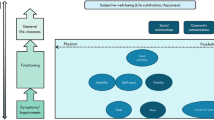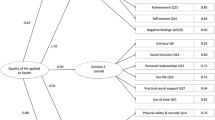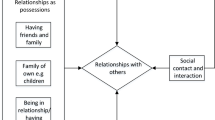Abstract
Quality of life (QoL) measures frequently conceptualise QoL as having distinct life domains. However, research suggests that there may be overlap. In this study, perceptions of links between life areas are explored. At time one, 143 participants in Khon Kaen, Thailand completed the “Global Person Generated Index” (GPGI), nominating up to five areas important to QoL. Participants then described why they perceived areas as important. Frequencies of links mentioned between areas were recorded. At time two, 42 participants completed the GPGI and were then asked to visually represent the areas of life with circles, overlapping, containing other circles or unconnected to show the interrelationships. Descriptions of the life areas often spontaneously included links with other life areas. “Money” was the most commonly linked area, followed by “job or work” and family. Diagrams representing the relationships between life areas showed diversity. All participants linked at least one area. About 26% presented at least one area as independent. Participants in this sample generally viewed their QoL as composed of some inter-related areas. This has implications for QoL measurement, suggesting data to capture inter-relating domains should be collected. The use of a mixed methods approach to understanding QoL is recommended. Implications for practice are also highlighted, as interventions aimed at one area of QoL will likely impact on others, in ways we currently do not measure.



Similar content being viewed by others
Notes
This paper describes research that formed part of a larger project (author’s PhD thesis).
References
Birnbacher, D. (1999). Quality of life - evaluation or description? Ethical Theory and Moral Practice, 2, 25–36.
Bowling, A. (1995). What things are important in people’s lives? A survey of the public’s judgments to inform scales of health related quality of life. Social Science and Medicine, 41(10), 1447–1462.
Brinkerhoff, M. B., Fredell, K. A., et al. (1997). Basic minimum needs, quality of life and selected correlates: explorations in villages in Northern India. Social Indicators Research, 42, 245–281.
Calman, K. C. (1984). Quality of life in cancer patients - a hypothesis. Journal of Medical Ethics, 10, 124.
Camfield, L., Crivello, G., et al. (2009). Wellbeing research in developing countries: Reviewing the role of qualitative methods. Social Indicators Research, 90, 5–31.
Cantor, N., & Sanderson, A. (1999). Life task participation and well-being: The importance of taking part in daily life. In D. Kahneman, E. Diener, & N. Schwarz (Eds.), Well-being: The foundation of hedonic psychology. London: Sage.
Cohen, L. (2000). A facet theory approach to examining overall and life facet satisfaction relationships. Social Indicators Research, 51(2), 223–237.
Creswell, J. (2010). Mapping the developing landscape of mixed methods research. In A. Tashakkori & C. Teddlie (Eds.), Sage handbook of mixed methods in social and behavioral research (pp. 45–68). London: Sage Publications Ltd.
Diener, E., & Biwas-Diener, R. (2001). Will money increase subjective well-being? Social Indicators Research, 57, 119–169.
Dijkers, M. (2003). Individualization in quality of life measurement: Instruments and approaches. Archives of Physical Medicine and Rehabilitation, 84(S2), S3–S14.
Doyal, L., & Gough, I. (1991). A theory of human need. Guildford: Guildford Publications Inc.
Hays, R. D., Sherbourne, C. D., et al. (1993). The RAND 36-item health survey 1.0. Health Economics, 2, 217–227.
Kahneman, D., Diener, E., et al. (1999). Well-being: The foundations of hedonic psyhcology. New York: Russell Sage Foundation.
Kahneman, D., Diener, E., et al. (2003). Well-being: The foundations of hedonic psychology. New York: Russell Sage Foundation Publications.
Kelley-Gillespie, N. (2009). An integrated conceptual model of quality of life for older adults based on a synthesis of the literature. Applied Research in Quality of Life, 4, 259–282.
Kosack, S. (2003). Effective aid: How democracy allows development aid to improve quality of life. World Development, 31(1), 1–22.
Marinelli, R. D., & Plummer, O. K. (1999). “Healthy aging: Beyond exercise”. Activities. Adaptation & Aging, 23(4), 1–11.
Martin, F., Rodham, K., et al. (2010). Reliability and validity of the Thai “Global person generated index”, an individualised measure of quality of life. Applied Research in Quality of Life, 5(3), 219–232.
McGregor, J. A. (2004). Researching well-being: Communicating between the needs of policy makers and the needs of people. Global Social Policy, 4, 337–358.
Mikkelsen, B. (1995). Methods for development work and research: A guide for practitioners. London: Sage Publications Ltd.
National Economic and Social Development Board (NESDB). (2002). “National Policy: The Ninth Plan Development Vision Framework 2002–2006”.
Neff, D. and W. Olsen. (2007). Measuring subjective well-being from a realist viewpoint. Methodological Innovations Online, 2. Accessed 21st August 2010 at http://erdt.plymouth.ac.uk/mionline/public_html/viewarticle.php?id=61.
Nussbaum, M., & Sen, A. (Eds.). (1993). The Quality of life. Oxford: Claredon Press.
Power, M., Harper, A., et al. (1999). The world health organization WHOQOL-100: Tests of the universality of quality of life in 15 Different cultural groups worldwide. Health Psychology, 18(5), 495–505.
Rahman, T., Mittelhammer, R. C., et al. (2003). Measuring the quality of life across countries: A sensitivity analysis of well-being indices. wider international conference on inequality, poverty and human well-being. Helsinki, Finland: WIDER International Conference on Inequality, Poverty and Human Well-Being.
Ruggeri, M., Bisoffi, G., et al. (2001). Subjective and objective dimensions of quality of life in psychiatric patients: A factor analytical approach: The South Verona outcome project 4. The British Journal of Psychiatry, 178(3), 268–275.
Schkade, D. A., & Kahneman, D. (1998). Does living in california make people happy? A focusing illusion in judgments of life satisfaction. Psychological Science, 9(5), 340–346.
Shahriar, J., T. Delate, et al. (2003). “Commentary on using the SF-36 or MOS-HIV in Studies of Persons with HIV Disease.” Health and quality of life outcomes 1: 25, doi:10.1186/1477-7525-1181-1125 available online at http://www.hqlo.com/content/1181/1181/1125.
Sirgy, M. J. (2002). The Psychology of quality of life. Drodrecht, The Netherlands: Kluwer.
Sirgy, M. J., Efraty, D., et al. (2001). A new measure of quality of work life (QWL) based on need satisfaction and spillover theories. Social Indicators Research, 55, 241–302.
Sprangers, M. A. G., & Schwartz, C. E. (1999). Integrating response shift into health-related quality of life research: A theoretical model. Social Science and Medicine, 48, 1507–1515.
Strack, F., Argyle, M., et al. (Eds.). (1991). Subjective well-being: An interdisciplinary perspective. Oxford: Pergamon Press.
Tabachnick, B. G., & Fidell, L. S. (2007). Using multivariate statistics. Boston, MA: Pearson Education Inc.
Ubel, P. A., Loewenstein, G., et al. (2003). Whose quality of life? A commentary exploring discrepancies between health state evaluations of patients and the general public. Quality of Life Research, 12(6), 599–607.
Veenhoven, R. (2000). The four qualities of life: Ordering concepts and measures of the good life. Journal of Happiness Studies, 1, 1–39.
Worthington, R. L., & Whittaker, T. A. (2006). Scale development research: A content analysis and recommendations for best practices. The Counseling Psychologist, 34(6), 806–838.
Acknowledgments
This research was funded by the Economic and Social Research Council (ESRC). This research was carried out when the author was a PhD student at the University of Bath, within the Department of Psychology and with support from the ESRC funded “Wellbeing in Developing Countries” Research Group. The author wishes to thank Drs Karen Rodham and Laura Camfield for their comments on the sections of the PhD thesis from which this paper is drawn.
Author information
Authors and Affiliations
Corresponding author
Rights and permissions
About this article
Cite this article
Martin, F. Perceptions of Links Between Quality of Life Areas: Implications for Measurement and Practice. Soc Indic Res 106, 95–107 (2012). https://doi.org/10.1007/s11205-011-9795-8
Accepted:
Published:
Issue Date:
DOI: https://doi.org/10.1007/s11205-011-9795-8




